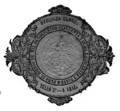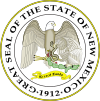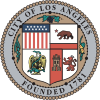National Coat of Arms of Mexico
The National Shield of Mexico (officially the National Shield of the United Mexican States) is one of the three national symbols, along with the flag and the national anthem, established by law in Mexico. Its current design was adopted in September 1968.
It is inspired by the legend of the founding of Mexico-Tenochtitlan, according to which Huitzilopochtli told the Mexicas to establish their city where they found an eagle perched on a cactus; the city was located in the Valley of Mexico, where Mexico City is located today.
Since February 1984, its use has been regulated by the Ministry of the Interior, based on the second chapter of the Law on the shield, flag and national anthem; with the title "Of the characteristics of the patriotic symbols", it is described in a general way:
Article 2 The National Shield is made up of an eagle and a Mexican snake, with the exposed left profile, the upper part of the wings on a higher level than the plume and slightly deployed in combat attitude; with the supporting plumage down touching the tail and feathers of it in natural fan. When the National Shield is reproduced on the back of the National Flag, the Mexican eagle will be presented in its right claw, holding the curved serpent with the left and the beak.
Regulations
Features
The law on the national coat of arms, flag and anthem defines the characteristics and use of the coat of arms; Regarding its shape or characteristics, it indicates in a general way that the shield:
SECOND CHAPTEROf the characteristics of the Symbols
ARTICLE 2.
-The National Shield is made up of a Mexican eagle, with the exposed left profile, the upper part of the wings on a higher level than the plume and slightly deployed in combat attitude; with the supporting plumage downwards touching the tail and feathers of this in natural fan. He puts his left claw on a flourishing nopal that is born in a rock that emerges from a lake, subject with the right and with the beak, in devouring attitude, to a curved serpent, so that it harmonizes with the set. Several penks of the nopal branch to the sides. Two branches, one of the oaks in front of the eagle and another of the laurel on the opposite side, form between both a lower semi-circle and join by means of a strip divided into three stripes which, when the National Shield is represented in natural colors, correspond to those of the National Flag.
When the National Shield is reproduced on the back of the National Flag, the Mexican eagle will be presented in its right claw, holding the curved serpent with the left and the beak. (DOF-additional radius 09-05-1995)
A model of the National Shield, authenticated by the three branches of the Union, will remain in the General Archive of the Nation, one in the National Museum of History and one in the House of Currency.
Use
- Reproductions
THIRD CHAPTERUse and Dissemination of the National Shield
ARTICLE 5. - All reproduction of the National Shield shall correspond faithfully to the model referred to in Article 2 of this Law, which shall not be changed or altered under any circumstances.
- Coin prints, official medals, stamps, official and similar paper, the law states:
ARTICLE 6. Authorities may make Official Use of the National Shield without authorization from the Ministry of the Interior. In addition, institutions and individuals, upon authorization by the Ministry of the Interior and strictly complying with the provisions of articles 2 and 5. of this Law, they may reproduce the National Shield when they contribute to the worship and respect of the Patriotic Symbol, as well as to spread its origin, history and meaning. When the Authorities make Official Use of the National Shield in coins, medals, stamps, paper, buildings, vehicles and Internet sites, in the reproduction of that Patriot Symbol you can only enroll the words "United Mexican States", which must form a higher semicircle in relation to the National Shield.
Use in flags
The law clearly stipulates three types of flags that are differentiated by the coat of arms:
Shield on official flag
The official flag must bear the coat of arms in full color as shown in the model.
ARTICLE 3o.-The National Flag consists of a rectangle divided into three vertical strips of identical measures, with the colors in the following order from the top: green, white and red. In the white strip and the center, it has the National Shield, with a diameter of three quarters of the width of the strip. The ratio between width and length of the flag is four to seven. You can wear a tie or tie of the same colors, at the foot of the moharra. A model of the National Flag, authenticated by the three branches of the Union, will remain deposited in the General Archive of the Nation and another in the National Museum of History
Shield in civil flag
The flag for civil use, on the other hand, must have the coat of arms in one ink, it is understood that it is on a white background with black lines to draw the coat of arms, but it does not indicate if it is a single-color version of the model coat of arms or is the one ink version to be reproduced on paper. This is one of the rarest flags to see because hardly anyone knows of its existence.
ARTICLE 32. - Individuals may use the National Flag in their vehicles, display it in their places of residence or work. In these cases the Flag may be of any size and with the coat of arms printed in black and white. The particular will observe the respect that corresponds to the national symbol and will be careful in its handling and polishing.
Shield on flags to trade
A third flag are those intended for trade, since the law says:
ARTICLE 33. - The copies of the National Flag for trade must satisfy the design and proportionality characteristics set out in Article 3.
But it never says which coat of arms should be used, so it can be interpreted that flags can only be sold for official use.
Surveillance
To take care of the proper use of the shield, the law itself clearly defines the office of the responsible federal executive:
ARTICLE 55.-Compete to the Ministry of the Interior to monitor compliance with this Law; in that function will be its assistants all the authorities of the country. It is the responsibility of the educational authorities to monitor their compliance with educational curricula. The above will be carried out in accordance with the corresponding regulations.(Sic)
Elements of the shield
The national emblem contains ten elements: cactus, eagle, snake, water, snails, chalchihuites, stone, laurel branch, oak branch, and tricolor ribbon. It is the national emblem with the largest number of biological elements (6).
Wildlife
The eagle and the snake stand out on the shield, although three small snails in the water are also included:
Eagle
The bird in the current Mexican coat of arms has been identified as the so-called golden eagle or also called caudal eagle with the scientific name Aquila chrysaetos, from the Latin: aquila, "eagle" and from the Greek: χρυσός, "golden" and ἀετός, "eagle", which is a species of accipitriform bird of the Accipitridae family. It is one of the best known and most widely distributed birds of prey on Earth. They live throughout much of North America, Eurasia, and North Africa. It is an endangered species as it has disappeared or its population is declining in many areas of Europe and North America.
In 1960, after compiling several notes by the Mexican ornithologist Rafael Martín del Campo, it was spread that he questioned the identification of the bird on the shield as a golden eagle. After years of studying pre-Hispanic representations of the so-called pre-Hispanic shields, he identified the bird like the cheriway caracara or "Mexican bearded vulture", a common species in Mexico (so naming it "eagle" is incorrect, since the caracara is a type of hawk). Either way, the golden eagle is considered the Mexican eagle for official purposes.
Snake
In the versions prior to the official coat of arms of 1916, the identification of the snake as an aquatic snake of some species impossible to determine was very common. Currently, Lake Texcoco, where the supposed serpent of Huitzilopoztli's design inhabited, is reduced to a regulating vessel for the drainage of the Metropolitan Zone of the Valley of Mexico. But as shown by Diego Durán, or as described in the decree of April 14, 1823.
1o.- That the shield be to the mexica eagle, standing on the left foot, on a nopal that is born of a rock between the waters of the lagoon, and holding with the right a CULEBRA in attitude of throwing it away with the beak;...
But since the 1916 model, the snake identified as a rattlesnake was introduced because it was more common for the cartoonist or because the species of aquatic snakes had already become extinct along with the dried up Lake Texcoco. Even in the overview only a curved snake is mentioned and only in the model is it shown with a rattlesnake. Regardless of this, the snake's current design and coloration does not correspond to any known snake species.
Flora
Cactus
The nopal is presented with five leaves (protruding parts of the nopal), a very unnatural shape, the eagle perches on it and also shows three red fruits identified as prickly pears with inflorescences, that is, flowers, something that would not be natural anymore that the flower falls off before the fruit turns red or any other color, in addition to the fact that its representation does not have thorns. Among the various species it has been said that this must be Opuntia ficus indica but because of the red fruit others propose Opuntia streptacantha. The so-called cactus pads have 32 frontal spines that some see as a representation of the 31 states of the Union plus the Federal District, although at that time the current states of Baja California Sur and Quintana Roo were federal territories and were only Entities. Federal as Mexico City is today. One interpretation of its "T" shape is that it represents the indigenous city of Mexico-Tenochtitlan, which is partly true since the topoglyph that was used in pre-Hispanic pictographic codices to point to that city was a nopal with fruits on flower on a land symbol but without the eagle, as shown in the Mendoza Codex and other pre-Hispanic or close to the conquest documents.
Oak and laurel
In front of the eagle there is a stylization of an oak branch with four leaves and three pairs of fruits, while behind it a laurel branch with the same number of fruits but with four groups of three leaves of the plant, in both cases the fruits are golden in color, which does not correspond to the true color of the fruits. Both species of European origin were used as a symbol of triumph or victory in Greco-Roman mythology, which is why in Europe they came to symbolize republican institutions in the 17th and 19th centuries, and the triumph of the republic over the monarchy. however, coincidentally the genus Quercus to which the illustrated holm oak belongs, has in Mexico the largest number of native species in the world with more than 150.
History
Huitzilopochtli had ordered the Mexicas to establish their territory and town in a place where they saw an eagle perched on a cactus devouring a snake. The history of the eagle and the serpent can be traced back to the founding of Mexico-Tenochtitlan around 1325, although many researchers believe it to be a founding myth that was created during the government of Itzcóatl (1427 to 1440) to affirm a kind of divine support for his supremacy over the other inhabitants of the Valley of Mexico. That was after they managed to prevail over the Tepanecs of the Altépetl de Azcapotzalco. After that, Itzcóatl ordered a general burning of books to be able to rewrite history to the taste of the Mexica without there being previous and contrary sources, as it was then, today it is the Mexican national symbol. The eagle on the cactus and with the snake in its beak is known by all Mexicans as the coat of arms of their country and they relate it to pre-Hispanic times.
Pre-Hispanic period
Contrary to the above, it has been argued that the sculpture of an eagle devouring a heart, present in the Tlahuizcalpantecuhtli temple in Tula, Hidalgo, and that the monolith called the National Shield Stone, a sculpture that represents a Teocalli or Temple of The Sacred War, which is carved with great care and mastery and is exhibited in the National Museum of Anthropology, in Mexico City, are its oldest representations. But, as said before, in the first sculpture a heart is devoured or held in its beak and not a snake, while in the other only the war glyph "Atl-tlachinolli" or "water that burns", which for some seems like a snake although it is not. In addition, the Stone of the National Shield is dated between 1507 and 1508, much later than the founding of Mexico-Tenochtitlan, and therefore neither would be a representation of the eagle devouring a snake. A similar situation occurs with the Mendoza Codex, where the eagle standing on a nopal is represented, a symbol of earth and a shield, but in this case it does not hold any type of object.
The chronicles of Fray Bernardino de Sahagún, Juan de Torquemada, Cristóbal del Castillo, Hernando de Alvarado Tezozómoc, Diego Duran and others do not do much to affirm that the founding myth predates Izcóatl, since all of them are after Izcóatl. 1519, as in the Crónica Mexicana by Hernando de Alvarado Tezozómoc that says:
... persuaded of the demon Huizilopochtli, they came to the beautiful city, which is now Mexico Tenochtitlan, because the day they arrived in this Mexican lagoon in the middle of it was and had a place of land and on it a rock and on top of it a great tunal; and in the hour that they came with their rafts of cannon and harbor found on the site the beautiful stone and tulle,
On the other hand, there is Fray Diego Durán who refers to two versions of the myth, one where he presents the eagle devouring a snake and in another he mentions it devouring birds with precious feathers, other chroniclers even only mention the eagle standing on the cactus without mention that he held or devoured something, as is the case with Cristóbal del Castillo who says that:
“I will guide you wherever you go, I will show myself as an eagle, I will call you where you will go (...) and when I have come to where I already feel good, where you will settle, there I will sit, there you will see me, I will no longer fly.”
On the other hand, there is a controversy about which species of bird is represented in the pre-Hispanic engravings and drawings, since the Mexican ornithologist Rafael Martín Ocampo, when relating the plumage, the habitat area of the bird species in the American continent and the diet described in pre-Hispanic works has proposed that it is actually the caracara or "quebrantahuesos" and not the golden eagle. In short, the representation as we know it today is not prior to the beginning of the Viceroyalty of New Spain in 1521.
Viceregal period
After the conquest and with a Spanish government firmly established in what they already called Mexico City, various interpretations of what would later become the national coat of arms began to be used as a kind of seal to distinguish themselves from the rest of the possessions de la Corona, the so-called "Mexican Eagle" formed by at least one eagle and one snake normally supported by the eagle with its beak at least, the use of these interpretations, for example, a shield similar to that granted to Mexico City on July 4, 1523, but where the Mexican eagle on the central tower differentiated it, in the same way the viceregal government put a similar representation of the eagle and the snake in official documents such as the case of La Gaceta de México between 1722 and 1821, it was also used in private works such as the ex libris of the Convento Grande de San Francisco, the title page of one of the first editions of the Compendious Narrative of Mexico by the author Juan de Viera, as well as in numerous engravings by José de Nava (1755), Emmanuel Villavivencio (1770 and 1782), José María Montes de Oca (1802), all of them engravers from the 17th and 18th centuries.
In terms of architecture, it was also used as a distinction, for example in the medallion on the front of the Academia de San Carlos, and which dates from 1784, a simpler form can be seen in the eagles on the facade of the old building of the Customs, and in the finials of the two portals of the Temple of Jesús María, the latter from the 18th century. In short, it became a symbol of the inhabitants of New Spain.
War of Independence
Between 1810 and 1821 the use of the Mexican eagle was fully accepted, to initiate Miguel Hidalgo y Costilla, Ignacio Allende and Juan Aldama not only used the figure of Our Lady of Guadalupe to champion the insurgent hosts, but also Ignacio Allende and It would not be strange that Juan Aldama ordered the preparation of a couple of flags that we know today as Allende's twin flags that had two fronts, the main one with the crowned image of Our Lady of Guadalupe as a symbol of New Spain and on the opposite side a very Distinguishing shield whose center has a Mexican eagle, these twin flags were forgotten for two hundred years since they were captured by the Royalists in 1811 and sent to Spain in 1814 where they remained until 2010 as a war trophy.
After that, the idea of a national shield was one of the bases to imply the sovereignty of the American people (indigenous, mestizos and criollos) against the Spanish government (the so-called gachupines), of that first shield There is no document known to make it official or great national seal, but it was widely used by the insurgents, on the flag of José María Morelos and on the seals of Ignacio López Rayón and José Sixto Verduzco in what was called the Supreme National Board. American or Supreme Government Junta of America. That first shield is distinguished by being very similar to the one popularly used in Mexico City, made up of a bridge with Roman arches, normally three, on which stands a cactus with fruits, on which an eagle perches with its wings. wings extended and which is crowned, around it are different weapons and flags that are supposed to be war trophies, in that first representation the eagle never holds a snake in its beak and it is very common to find it associated with the name of Fernando VII. This first government only controlled some areas of the country between 1811 and 1813, and ended up falling apart without achieving a real government.
Then, between 1813 and 1815, the Congress of Anahuac was organized, which did have the form of its own government, and which took the step towards the formal creation of the first national symbols, with three different flags and a large seal and shield of the nation, the latter promulgated by General José María Morelos in a decree of July 3, 1815, where the nation is also named as Mexico without adding the other names by which until then it was named, North America, America Mexican or America. That first decree said:
That the Supreme Mexican Congress, wanting to conform to a whole with the customs that the right of nations has introduced into the sovereign governments, and finding itself in the case of reforming the old coat of arms so that the latter will serve as a distinctive one, as well as to recognize its pavilion as to authorize its orders, diplomas and all kinds of instruments proper to its high and sovereign functions, has decreed:"Although the offices given above are firm and worthwhile with the first seal that was said of the Supreme Board, but that henceforth they are recognized by sands and great seal of the Mexican Republic, the following:
"In a silver field shield an Eagle will be placed standing with a snake on the beak and resting on a nopal loaded with fruit, whose trunk is fixed in the center of a lagoon. The war trophies will worship the shield, and a civic crown of laurel will be placed at the top of it, through which the center will cross a tape with this inscription: Mexican Independence, year of a thousand eight hundred ten. These weapons will form the Great Seal of the Nation, with which the decrees in which the laws, the powers of plenipotentiaries and other diplomatic ministers are sanctioned, the offices of all kinds of employees, the ones expiating the Supreme Court of Justice, and the passports for foreign nations, without any chief or junior magistrate being able to use it.(Sic)
This stamp only had a limited life to that of the Anahuac Congress, after which it ceased to be used although it seems never to be forgotten. For example, General Vicente Guerrero used a counterstamp for coins that clearly recalls a national coat of arms, even with the crown of holm oak and laurel, other insurgents used similar reseals.
First Empire
After independence and still under the government of the First Regency an order is issued to clarify the form and use of the colors of the national flag, it says:
Order. The coat of arms of the empire is designated, and the colours of its pavilion.November 2 of 1821.
Entered the sovereign provisional governing board of this empire, of the exposed V. E. of order of the regency with dates 6 and 16 of the immediate October, manifesting the need to determine the shield of imperial weapons, and the seals that should serve for the authenticity of certain roles, and those that also have to fix the national pavilion, has solved the first thing: that the weapons of the empire for all classes of seals, be only the nopal born.
The second: that the national pavilion and flags of the army should be tricolours, adopting the green, white and incarnated colors in vertical strips, and drawing on the white a crowned eagle; all in the form presented by the attached design.
November 2 of 1821.(Sic)
Which was clarified and formalized by the decree of January 7, 1822 that was issued with the said models and whose originals were lost although many examples survive in coins of the time.
Decree. Empire's weapons shield and stamps to serve.January 7 of 1822
Having taken into consideration the sovereign interim governing board of the empire, the need to determine the shield of the imperial weapons, and the seals that must serve for the authenticity of certain roles, as well as the setting of the national pavilion, has had to decree and decree: the first, that the weapons of the empire, for all kinds of seals shall be only the nopal born of a small, white,
This first design of the shield is distinguished above all by being a very thin eagle, with wings located behind the body as if it had just landed and it never supports a snake, nor is it crowned by laurel or olive branches.
First Republics
After the fall of the First Mexican Empire, the First Constituent Congress decreed a new shield on April 14, 1823, which read:
Decree. Arms shield and national pavilion.April 14 of 1823
The sovereign Mexican Constituent Congress, as a result of the government consultation, of 9 current, on whether or not the shield of arms and national pavilion should be changed, has been decreed.
1o.- Let the shield be to the mexica eagle, standing on the left foot, on a nopal that is born of a rock between the waters of the lagoon, and holding with the right a snake in attitude of throwing it away with the beak; and pray this two branches, one of laurel, and the other of holm oak, according to the design used by the government of the first defenders of independence.
2o.- As for the national pavilion, he is adopted here, with the only difference of placing the eagle without crown, the same thing that must be done on the shield.
As can be read, the differences between both shields are simple, the second lacked the crown and added the olive and laurel wreath, which were related to the political regime of the Republic. This shield was never officially suppressed or changed by the republican governments of Mexico, both federalist and centralist between 1823 and 1879, although in practice there were a multitude of designs, among which the most popular was only formed by the eagle and the serpent. without nopales or laurel and olive wreath, an example of this can be seen in the shield of the flag of the San Blas Battalion, on the other hand during the Ayutla revolution and the Reform War the liberal groups showed the eagle looking towards the color green, to the left of the observer, to differentiate themselves from the conservative groups, on whose shields the eagles faced red or to the right.
Second Mexican Empire
During the period covered by the so-called Second Mexican Empire, between 1863 and 1867, three changes occurred for the monarchical government in the design of the national coat of arms. The first of them occurred under the government of the Regency of the Empire who offered Archduke Maximilian the crown of Mexico, in this first decree of September 20, 1863, it is described as:
...the MEXICAN IMPERY REGENCE, in view of the opinion of the Under-Secretary of State for Foreign Affairs, decrees:Single article. In the future, the coat of arms of the Empire will be according to the following description: At the center of an imperial mantle, collected at its ends, forming a pavilion, with a tricolor, green, white and incarnated loop, with the motto RELIGIÓN, INDEPENDENCE And UNION, rematizing the upper part of that one with a crown of the same class, will be the Mexican Eagle within an enhanced shield, in the attitude of always, that is, standing on the nopal, and the snake roasted with the beak and a claw: in the head will have the imperial crown.
At the top of the shield there will be the plume of seven feathers, of the ancient Aztec Monarchs: on the sides of it will be seen on the right, in a bush, the hand of Justice, and on the left the Imperial Cisterre. Half of the sides of the shield will be represented, in one, the plain, and in the other the carcax. These four emblems will appear as if they were placed behind the shield, seeing only the main part of them.
The collar of the Great Cross of the Imperial Order of Guadalupe will be pendened by the carcax and the macana, serving the entire armrest, in union with the branches of laurel and holm oak, which have always had those of the Nation.
This shield, whose design will circulate with this decree, symbolizes the former Mexican Monarchy; the National Sovereignty acquired by Independence in 1821, and the erection of the Sanctioned Empire lately.
The Under-Secretary of State and Foreign Business is responsible for the implementation of this decree.
Given at the Imperial Palace of Mexico, September 20, 1863.-John N. Almonte.-José Mariano de Salas.-John B.Ormaechea. (Sic)
A model of this shield is in the Museum of Mexican History in the city of Monterrey, for some reason this shield has been linked to the First Mexican Empire which did not use it unlike the Imperial House of Agustín de Iturbide who He adopted it as his own and continues to use it to this day.
After that decree, Maximiliano and his wife Carlota were accepted and arrived in Mexico, who apparently did not like the previous design or simply used one more appropriate to their custom, that is why on June 18, 1864, the already called Maximilian I of Mexico promulgated a decree by which he gave a new coat of arms to the monarchical nation, but this decree was based on models that apparently were never created and were largely forgotten. This decree said:
”MAXIMILIANO, Emperor of Mexico:We have decreed and decreed the following:
Art. 1o. The Empire's Gun Shield is the one that points to model number 1.
Art. 2nd. The flags of the State are those designated in model number 2.
Art. 3rd. As a result, all previous provisions on this matter are repealed.
This decree shall be deposited in the Archives of the Empire, and shall be published in the appropriate manner for its prompt fulfillment.
Given at the Mexican palace, 18 June 1864. -MAXIMILIANO...
This decree, as said before, should not have been widely disseminated, which is why on November 1, 1865, a new decree was promulgated describing the official coat of arms. This one said:
”MAXIMILIANO, MEXICO EMPERADOR:Seen as determined in Art. 78 of the Statute.
We'll be right.
The Empire’s coat of arms is oval shape and blue field: it carries in the center the eagle of the Anáhuac, of an intern profile, held by a nopal, supported by a rock flooded with water, and tearing the serpent: the embroidery is of gold, loaded with the holms of holm oak and laurel, cluttered with the imperial crown: by means of supports has the two All according to the accompanying model, marked with number 1.
The colors of the national pavilion are: green, white and red, placed parallel to the asta in the same order in which they are listed and in equal dimensions each.
The adornments of the Imperial are, the Shield of weapons on the white colour, and four eagles on the nopal, crowned, on the four corners of the pavilion.
The war one has no more adornment than the crowned eagle on the nopal in the center of the white color.
In order for the form to be regular and a single one, it will be taken care to give the pavilions in length double dimensions that in width; to the flags of the bodies equal dimensions along with wide, and that the gallardete is twenty times longer than wide in its birth, as it is put in sight by means of the designs attached to this decree, in the print marked as number 2.
Our Minister of State is responsible for the execution of this decree.
Given in Mexico, 1st. November 1865.-MAXIMILIANO...(Sic)
Obviously this decree did not last longer than the empire and was only applied where its power reached. In this same context, there is a model of the shield in the Museum of Mexican History in the city of Monterrey, which includes an imperial mantle over the Coat of arms of the Empire, it is believed that this version was a design for the exclusive use of the emperor or his family.
Federal Republics
As said before, the shield was very varied, with very little respect for the original design, between 1846 and 1879 the federalist governments and liberal groups tended to use designs inspired by French imperial eagles, which fluctuated between lateral and frontal postures of the eagle, being the last one the most usual, at that same time it was common for them to put the inscriptions "República Mexicana" and to a lesser degree "United Mexican States", in addition to that they added flags, weapons, Phrygian hat, suns, solar rays and many other things.
Because of the above, after coming to government through the Tuxtepec Plan, the then President Porfirio Díaz undertook the task of normalizing the chaotic use of the shield, issuing a decree that largely regulated the use and model of the shield. Although this was only a circular where the then Secretary of Public Instruction Diez Gutiérrez made it known that the decree of April 14, 1823 was in force, and that this shield should be used as the official one, this circular of December 30, 1880, was a little ambiguous since there was no known model of the original, for which the artist Tomas de la Peña was entrusted with the design of a model, his design did not deviate much from the general model that had been Frenchified since 1846, that design It was used with some variations until 1916, although in 1898 another design was released that did not differ much from the previous one, it is said that it was even a little more Germanic than Frenchified, the design was the work of Juan de Dios Fernández and when used near of the festivities of the Centennial of Mexican Independence, it was popularly known as the Águila del Centenario, and not only because of the party, since it was the eagle that was minted on the front of the coins called Centenario, it is Despite not being the official version, this version of the shield was used until the 1940s on legal tender coins.
Carranza Shield
During the first stage of the Mexican Revolution, both sides used the shield models of the Porfiriato, but since the revolutionary groups were very heterogeneous, it was not unusual for each one to make their own shield as it had been in the past, in this way during the second stage of the Revolution when Victoriano Huerta had already taken the presidential power and the Governor of the state of Coahuila, Venustiano Carranza rebels against his government, the use of the same design causes some conflicts for which the so-called First Chief of the Constitutionalist Army in 1914 Shortly after the start of the war, he ordered a design to be made that clearly identifies the troops of the Constitutionalist Army from the troops of the Federal Army. This design was the work of the artist Antonio Gómez R. and was not made official until 1916 when the Carrancista group had imposed itself on the revolutionary group that supported the government emanating from the Convention of Aguascalientes, in this way and close to carrying out ar the Constituent Congress of 1917, Venustiano Carranza promulgated a decree on September 21, 1916 that makes it official and which says:
Don Venustiano Carranza Head of the Constitutionalist Army, in charge of the executive branch of the Union, in use of the powers that I am invested, and,Considering: that the decree of 14 April 1823 is in force, by which the Sovereign Constituent Congress ordered that the national shield “be the Mexican eagle, stand on the left foot on a nopal that is born of a rock between the waters of the lagoon, and grasping with the right a snake in the attitude of throwing it away with the beak; and that they orang this blashon two branches,
Considering: also, that this decree has been given to different interpretations in its graphic expression, giving rise to an infinite variety in the figures of the eagles used by the various authorities of the Republic, thus missing a precise form of national shield,
I have had the following decree issued:
Single article. The national shield, whose model is deposited and preserved in the direction of the General Directorate of Fine Arts, is the only one to be used by the civil and military authorities of the Republic, and by diplomatic and consuls representatives accredited abroad. Copies of this model will be distributed to the governors of the federative entities and to the public offices dependent on the Federal Government. This decree will begin to govern from the first day of October. Therefore, command is printed, published, circulated and properly enforced.
Given at the Palacio del Poder Ejecutivo Federal, in Mexico on the twenty days of the month of September 1916.-Venustiano Carranza.-Robrication – the engineer citizen Félix F. Palavicini, Assistant Secretary of Public Instruction and Fine Arts.
I write it to you for your knowledge and consequent purposes.
Constitution and Reforms. Mexico, September 21 of 1916.- The manager of the Office, Felix F. Palavicini.
The model of this shield seems to have never been deposited in the General Directorate of Fine Arts and that the model that survived the revolution was in black and white, so there was not much consistency in its coloring by the many institutions public and private companies that copied it, even after 1918 a model by Manuel Carrera Stampa appeared, which was never official but was used as such.
Institutionalist Shield
Later, during the fourth and fifth stages of the Mexican Revolution, the political groups that operated during the so-called Maximato wanted to separate from their Carrancista past, carrying out a kind of contest to select a new design for the shield, from this contest limited to For certain people, the artist Jorge Encino was the winner, who proposed two designs, one with a complete laurel and holm oak crown that would be used to put on the flags and another design with a short laurel and holm oak crown that is completed with the full name of the country. UNITED MEXICAN STATES" that would be used for documents, coins, medals and seals, this design is characterized by changing the traditional rock from which the cactus is born for a land symbol of the Nahuatl pictographic language, in addition to being inscribed in a circle of frets in shaped like spikes and have the phrase written in Art Nouveau type letters. This design was formalized by means of a decree of February 5, 1934, the decree then said:
The C. Deputy Constitutional President of the United Mexican States, the following decree has been addressed to me:“ABELARDO L. RODRIGUEZ, Constitutional President Substitute of the United Mexican States, to its inhabitants, know:
That in the use of the power vested in me in article 89, paragraph I, of the Constitution of the Republic; and
CONSIDERING: That in 14 April 1823 the Sovereign Constituent Congress issued a decree establishing the characteristics that the National Shield should have, as a symbol of the ideas and feelings that the new regime of the Nation reported, determining that the Shield would conform to the one used by the Government of our first defenders of Independence:
CONSIDERING: That with the course of time and through the political vicissitudes of our nascent nationality, that shield was undergoing some modifications, although with speciality, under the republican regimes, the essential traits that the decree of 14 April 1823 pointed out;
CONSIDERING: That such discrepancies in the artistic composition of the National Shield have given rise to various initiatives, aimed at printing due unity and different measures aimed at achieving it, and that to that end the First Chief of the Constitutionalist Army issued, in 21 September 1916, a decree in which, recognizing the inconvenience of the National Shield having different graphic interpretations, the chosen Bella was sent to
CONSIDERING: That the so-called decree of 21 September 1916 did not come to fruition because of the failure to make the deposit ordered, which motivates the subsistence of various graphic interpretations;
CONSIDERING: That the adoption of a definitive model of the National Shield is an infallible necessity for being the symbol of nationality itself, the emblem in which traditions are remembered and complied with, the heroic struggles that the people have sustained for their freedom, the most climaxing events of our history and even the essential characteristics of the race.
For the above considerations, and in compliance with the above-mentioned legal provisions, I have had to issue the following
DECRETO
Article 1. They are adopted as models of the National Shield, for their various uses, which, duly authenticated with the signatures of the President of the Republic, of the President of the Permanent Commission of the Congress of the Union, of the President of the Supreme Court of Justice and of the Secretaries of State, are deposited with this date in the General Archive of the Nation, and of which a copy will be preserved, also authenticated in the National Museum of Archaeology.
A bit of the coin and medal model will be delivered for your guard to the Coin House.
Article 2. This Shield, in its respective models, will be the only one who will henceforth bear the flags, coins, medals and correspondence of all the country's public offices, as well as the Shields of the Embassies, Laws and Consulates abroad.
Article 3. The reproductions other than the models adopted by this decree are prohibited.
TRANSITOR
Single article. Proceed to make the necessary reproductions and copies of the models to be sent to all units of the Public Service, with the indication that, as soon as possible, they are imposed on their services.
Pursuant to section I of article 89 of the Constitution of the United Mexican States and for its proper publication and observance, I promulgate this decree in the residence of the Federal Executive, in the city of Mexico, D.F., on the five days of the month of February of a thousand nine hundred and thirty-four. - A.L. Rodriguez. - Rubber. The Secretary of State and the Office of the Interior, Eduardo Vasconcelos. Factory.”
What I communicate to you for your publication and other purposes.
Effective suffrage. No re-election.
Mexico. D.F., February 5, 1934. - The Secretary of Government, Eduardo Vasconcelos. - Rubber.
This new design also formalized the so-called Day of the National Flag and Shield, which has been celebrated since then every February 24. This 1934 shield continued in use until 1968, although by 1966 its little use was already noticeable, as shown in the model, to begin with, the outer circle had been removed, after that the official name had been removed of the country, or changed the font to the full name of the country, the model for the flag and the one used for papers, stamps, coins, etc. were used interchangeably, in addition to that, two designs were used with only black lines that would serve for the One ink impressions on official documents, stamps, coins, bas-reliefs and other similar uses, these designs were never made official although they were used.
Current shield
Due to the whole series of problems mentioned with its use of the shield and also with the flag, it is that on September 30, 1966 the Congress of the Union based on Art. 73, section XXIX-b of the Constitution of 1917 opens a contest to select a new design for the coat of arms and the flag, at the same time that it gives entry to an initiative to create a law that formalizes and clarifies its use, that first law received the name of Law on the characteristics and the use of the National Coat of Arms, Flag and Anthem, was approved by Congress on December 23, 1967 and published in the Official Gazette of the Federation on August 17, 1968.
The new model that was presented on September 16, 1968 was the work of the architects Pedro Moctezuma Díaz Infante and Francisco Eppens Helguera, its design differed above all from the 1934 model in that it uses a Nahuatl glyph to represent the lake, which is adorned with glyphs of shells and jewels. But as in the previous case, its representation had problems, from the beginning, a model for one-ink impressions was not foreseen, that is why in 1984 a new law was created, which with later changes and additions is the current Law on the Shield, the Flag and the National Anthem.
Shield Examples
Presence in other shields
Nationals
| Federative Entity | Shield | Description | |||||
|---|---|---|---|---|---|---|---|
| Querétaro | Modified version of the current shield: the garlands have been suppressed. | ||||||
| State of Mexico | Sello de México which, in turn, is an alternate version of the current shield. | ||||||
| Oaxaca | Modified version of the current shield: a tricolour loop has been added to the nahuatl glyph of the rock. | ||||||
| Sinaloa | Modified version of an earlier version of the national shield. | ||||||
Foreigners
Variants of the National Coat of Arms of Mexico are used officially outside of Mexico.
| Place | Shield or seal | Description | |||||
|---|---|---|---|---|---|---|---|
| New Mexico | As part of the shield of the federated state of New Mexico in the United States of America, as a kind of remembrance over the sovereignty it had over the territory until the American invasion between 1846 and 1848, this shield with minor variations is officially used since 1850. | ||||||
| Los Angeles | The city of Los Angeles has on its shield a modification of the Mexican national shield, in its internal division, inferior, right. Do not confuse with Los Angeles County or the Los Angeles Metropolitan Zone. This shield with minimal variations is official since 1905. | ||||||
| French Foreign Legion | As part of the shield 1 Regiment based in Aubagne where is the headquarters of the French Foreign Legion, this in remembrance of the Battle of Camarón, which occurred during the French Intervention in Mexico on April 30, 1863 and also in 1862, which in the doctrine of the Legion represents the greatest sacrifice that the Legion had to give for its adoptive homeland and that each year they celebrate and commemorate the use of the white flag to perform the same | ||||||
Interpretations
The national coat of arms has very remote antecedents and several of the elements it consists of have changed their meaning over time. For the ancient Mexicas, the eagle meant the most majestic of birds, it represented the zoomorphic attire of the sun, being this at the same time, the main deity of said town; The tuna represented the heart of man, from whose liquid the sun king fed for his daily journey from east to west, to fight the night and return victorious. This analogy gave rise to placing the representation of the bird in a main place, since it represented the sun in the hunt for stars (men) through sacrifice. After the appearance of the serpent in the representations of the shield at the end of the XVI century; the myth was taken up again for evangelizing purposes by the Spanish conquistadors. Given the relationship of the serpent with the forces of evil, made by the European narrative tradition; Representing it as the creature that is devoured by the supreme deity (the eagle), invited to give the shield meaning the triumph of good over evil. This bird also had a strong iconographic link to virtue and state power.
The original meaning of the symbols was different in many ways. The eagle was a representation of the sun god, Huitzilopochtli, who was very important, as the Mexica called themselves "the people of the Sun". The nopal, with its fruits, called "tenochtli" In Nahuatl, it represents the island on which the city of Tenochtitlán was founded. For the Aztec people, the snake represented wisdom and had connotations related to the god Quetzalcoatl. Among the Mexicas, this scene with the eagle devouring the serpent would be considered inappropriate. The story of the serpent was derived from an incorrect translation of the chronicle Mexicayotl by Hernando de Alvarado Tezozómoc. He translated the Nahuatl phrase ihuan cohuatl izomocayan , "the serpent hisses", as "the serpent is destroyed." Based on this, Father Diego Durán reinterpreted the legend, so that the eagle represented good, while the serpent represented evil and sin. Despite its imprecision, this meaning was adopted since it corresponded to the European heraldic tradition. Therefore, although this vision does not correspond to pre-Columbian traditions, missionaries were used for catechism and the conversion of indigenous peoples to Christianity. Father Durán would first use this version of the story in 1582 to illustrate his "Atlas de la historia de los indios de la Nueva España e islas de Tierra Firme", and it was soon adopted by others.. It would not be until the War of Independence that it would be used as a coat of arms.
Contenido relacionado
Aetius
Operetta
Panocho
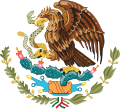













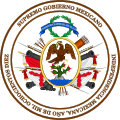











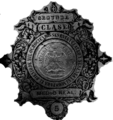


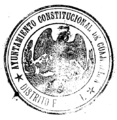

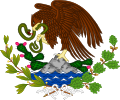



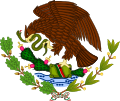







![moneda con el sello para monedas SUD, como se dio en Decreto por José María Morelos[30]](https://upload.wikimedia.org/wikipedia/commons/thumb/6/6e/8_reales_SUD_de_M%C3%A9xico_de_1812_%28cobre%29%28anverso_y_reverso%29%2801%29.JPG/120px-8_reales_SUD_de_M%C3%A9xico_de_1812_%28cobre%29%28anverso_y_reverso%29%2801%29.JPG)




